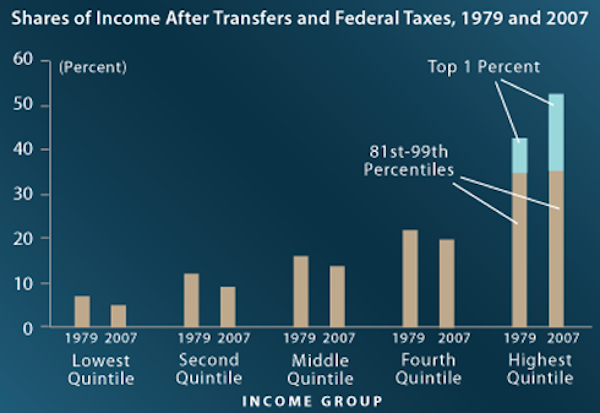 The Lookout
The LookoutNew numbers: Income for top 1 percent skyrocketed over last 30 years

So you already know that the gap between rich and poor has been widening lately. But some new numbers from the Congressional Budget Office put the issue into stark relief.
As the chart at right shows, between 1979 and 2007, the share of after-tax income going to each of the bottom four income quintiles--the bottom 80 percent--has dropped. The only quintile that has increased its share is the top 20 percent. And the top 1 percent has more than doubled its share.
That top 1 percent saw its income skyrocket by 275 percent. Those between the 80th and 99th percentile--that is, the top 20 percent, excluding the very top 1 percent--also did pretty well, seeing their income rise by 65 percent. Income for the bottom 20 percent, meanwhile, grew by just 18 percent.
One reason for the growing gap, the report said, is the impact of government transfer programs. Back in 1979, the poorest 20 percent of the population received 50 percent of all government transfers. By 2007, that had dropped to 35 percent, thanks largely to increases in spending on Social Security and unemployment benefits, which aren't focused exclusively on poor households.
The Occupy Wall Street movement has made inequality a key focus of its protests, and has used the slogan, "We are the 99 percent." After starting in lower Manhattan last month, the movement has spread across the country, and has succeeded at helping to put the inequality issue into the media and political spotlight.
Want more of our best national affairs stories? Visit The Lookout or connect with us on Facebook and follow us on Twitter.
Other popular Yahoo! News stories:
• California researcher cracks secret society's cipher
• Obama approved fewer regulations than Bush, but more expensive rules
• Who is 'the Foreigner,' al-Qaida's new aid emissary to Somalia?
